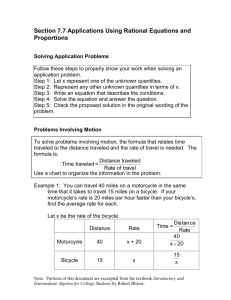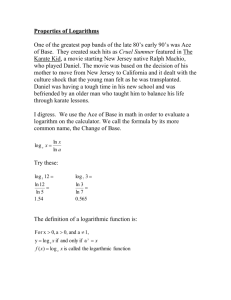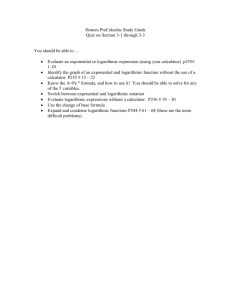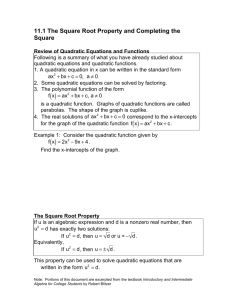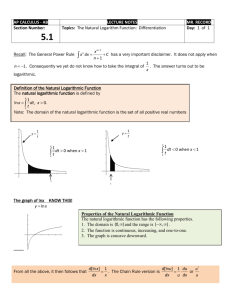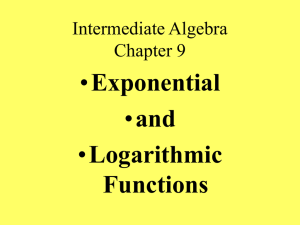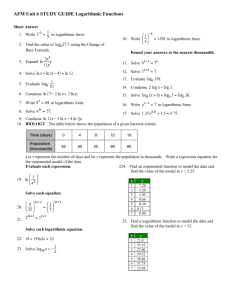Section 12.2 - MiraCosta College
advertisement
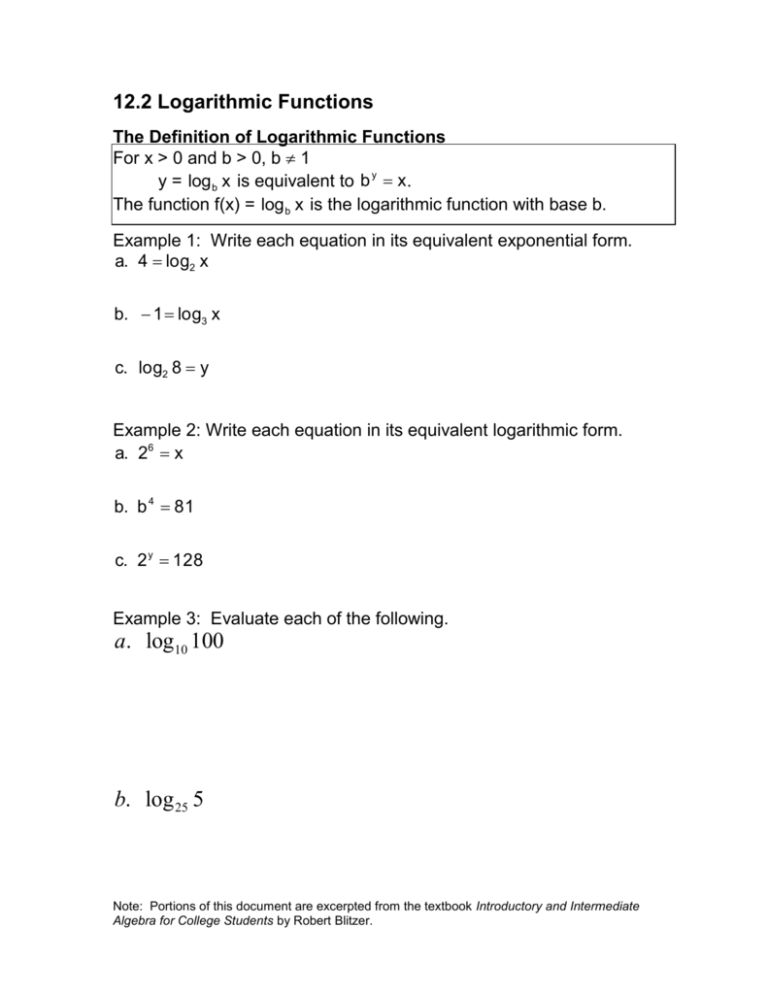
12.2 Logarithmic Functions
The Definition of Logarithmic Functions
For x > 0 and b > 0, b 1
y = log b x is equivalent to b y x.
The function f(x) = log b x is the logarithmic function with base b.
Example 1: Write each equation in its equivalent exponential form.
4 log x
a.
2
b. 1 log3 x
c. log2 8 y
Example 2: Write each equation in its equivalent logarithmic form.
a. 26 x
b. b 4 81
c. 2 y 128
Example 3: Evaluate each of the following.
a. log10 100
b. log 25 5
Note: Portions of this document are excerpted from the textbook Introductory and Intermediate
Algebra for College Students by Robert Blitzer.
c. log 5
1
5
d. log 2
1
16
Note: Portions of this document are excerpted from the textbook Introductory and Intermediate
Algebra for College Students by Robert Blitzer.
Basic Logarithmic Properties
Logarithmic Properties Involving One
1. log b b 1
because 1 is the exponent to which b must be
raised to obtain b. ( b1 b )
2. log b 1 0
because 0 is the exponent to which b must be
raised to obtain 1. (b 0 1)
Inverse Properties of Logarithms
For b > 0 and b 1,
The logarithm with base b of b raised to a
logb b x x
power equals that power.
logb x
b
x
b raised to the logarithm with base b of a
number equals that number.
Example 4: Evaluate each of the following.
a. log 8
8
b. log1.5 1.5
c. log 8 1
d. log1.7 1
e. log 8 8 5
f . log 5 5 2.3
g. 7 log7 8.3
Note: Portions of this document are excerpted from the textbook Introductory and Intermediate
Algebra for College Students by Robert Blitzer.
Graphs of Logarithmic Functions
The logarithmic function is the inverse of the exponential function with
the same base. Thus the logarithmic function reverses the
coordinates of the exponential function. The graph of the logarithmic
function is the reflection of the exponential function about the line
y=x.
Characteristics of the Graphs of Logarithmic Functions of the Form
fx logb x .
1. The x-intercept is 1. There is no y-intercept.
2. The y-axis is a vertical asymptote.
3. If b > 1, the function is increasing. If 0 < b < 1, the function is
decreasing.
4. The graph is smooth and continuous. It has no sharp corners or
gaps.
Example 5: Graph fx 3x and gx log3 x on the same coordinate
system.
Note: Portions of this document are excerpted from the textbook Introductory and Intermediate
Algebra for College Students by Robert Blitzer.
Example 6: Graph f x log 1 x
2
The Domain of a Logarithmic Function
In the expression y= log b x , x is the number produced when y is used
as an exponent with base b, b > 0. Since b is always positive, x must
also be positive. Thus the domain of the logarithmic function is x > 0,
or all positive real numbers.
In general:
domain of fx logb x c consists of all x for which x + c > 0.
Example 7: Find the domain of the logarithmic function.
fx log5 x 7
Note: Portions of this document are excerpted from the textbook Introductory and Intermediate
Algebra for College Students by Robert Blitzer.
Common Logarithms
The logarithmic function with base 10 is called the common
logarithmic function.
The function fx log10 x is usually expressed simply as f x logx .
Most calculators have a “log” key that can be used to perform
calculations with base-10 logarithms.
Logarithmic functions may be used to model some growth functions
that
start with rapid growth and then level off.
Example 8: The percentage of adult height attained by a girl who is
x years old can be modeled by
fx 62 35log(x 4)
where x represents the girl’s age (from 5 to 15) and f(x)
represents the percentage of adult height. What percentage of
adult height has a 10-year old girl attained?
Note: Portions of this document are excerpted from the textbook Introductory and Intermediate
Algebra for College Students by Robert Blitzer.
Natural Logarithms
The logarithmic function with base e is called the natural logarithmic
function.
The function fx loge x is usually expressed simply as fx ln x .
Most calculators have an “ln” key that can be used to perform
calculations with base-e logarithms.
Example 9: Find the domain of the function.
a. f x ln x 3
Example 10: Simplify each expression.
a. ln e
b. ln e 4
c. eln7
d. ln e1.5x
e. e ln3x
Note: Portions of this document are excerpted from the textbook Introductory and Intermediate
Algebra for College Students by Robert Blitzer.
Summary of Properties of Logarithms
General
Common
Properties
Logarithms
log1 0
1. log b 1 0
log10 1
2. log b b 1
3. logb b x x
4. b logb x x
log10 x x
10 log x x
Natural
Logarithms
ln1 0
lne 1
lne x x
eln x x
Note: Portions of this document are excerpted from the textbook Introductory and Intermediate
Algebra for College Students by Robert Blitzer.
Answers Section 12.2
Example 1:
a. x 2 4
Example 2:
a. log2 x 6
b. x = 31
b. logb 81 4
c. 2 y 8
c. log2 128 y
Example 3:
a. log10 100 2
1
b. log 25 5=
2
1
c. log5 = 1
5
1
d. log 2 = 4
16
Example 4:
a. 1
b. 1
c. 0
d. 0
e. 5
f. 2.3
g. 8.3
Example 5:
Note: Portions of this document are excerpted from the textbook Introductory and Intermediate
Algebra for College Students by Robert Blitzer.
Example 6:
Example 7: {x| x > 7}
Example 8: f(10) 89.23 A 10-yr old girl has attained about 89% of
adult height.
Example 9: {x| x > 3}
Example 10:
a. 1
b. 4
c. 7
d. 1.5x
e. 3x
Note: Portions of this document are excerpted from the textbook Introductory and Intermediate
Algebra for College Students by Robert Blitzer.
